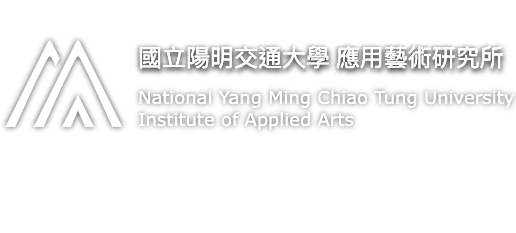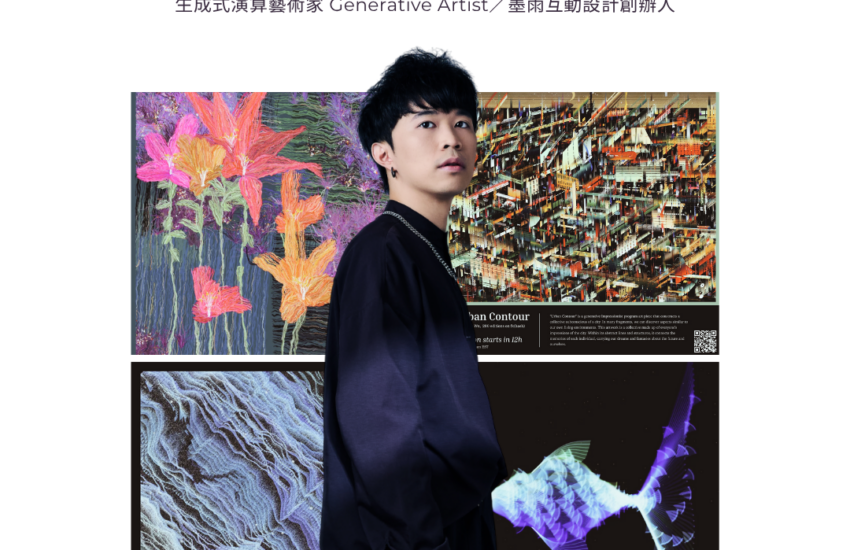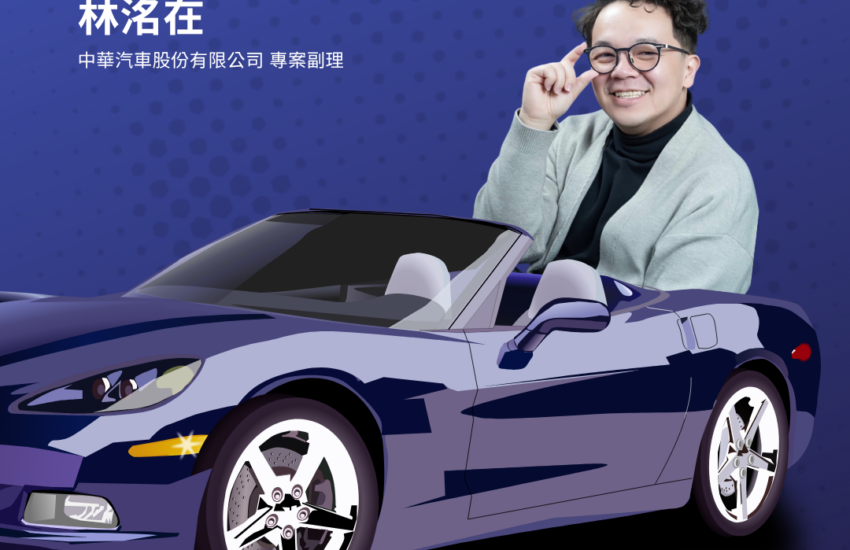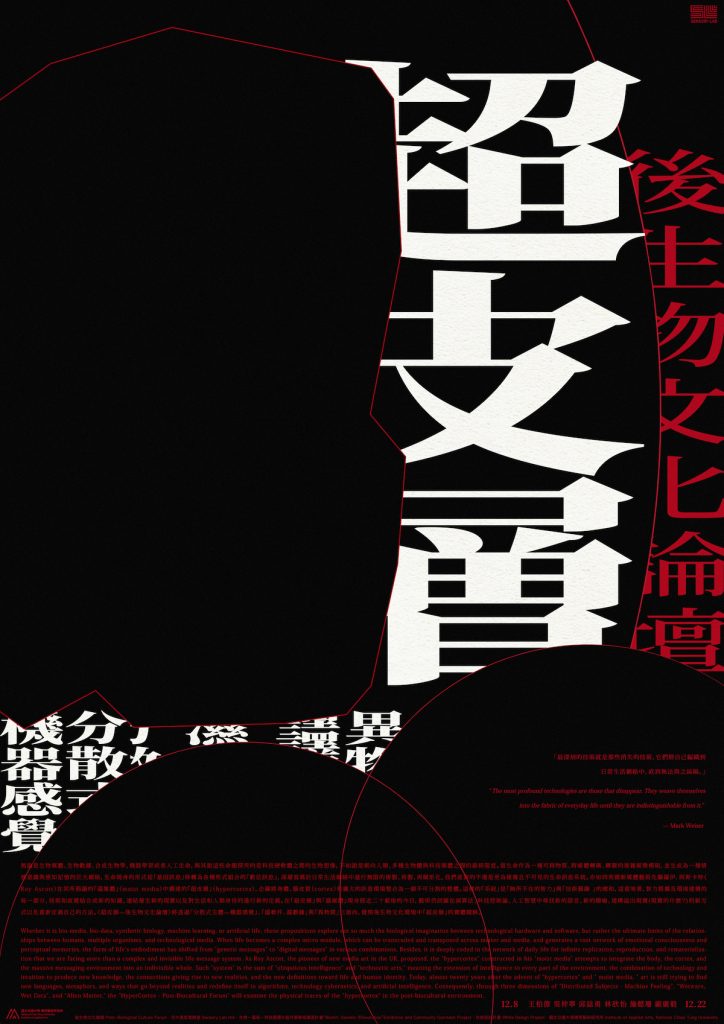
“最深刻的技術就是那些消失的技術。它們將自己編織到日常生活網絡中,
直到無法與之區隔。The most profound technologies are those that disappear.
They weave themselvesinto the fabric of everyday life
until they are indistinguishable from it.”—Mark Weiser
無論是生物媒體、生物數據、合成生物學、機器學習或者人工生命,與其說這些命題探究的是科技硬軟體之間的生物想像,不如說是朝向人類、多種生物體與科技媒體之間的最終限度。當生命作為一種可跨物質、跨媒體轉碼、轉置的複雜細微模組,並生成為一種情感意識與感知記憶的巨大網絡,生命現身的形式從「基因訊息」移轉為各種形式組合的「數位訊息」,深層寫碼於日常生活網絡中進行無限的複製、再製、再賦形化,我們面對的不僅是更為複雜且不可見的生命訊息系統,亦如同英國新媒體藝術先驅羅伊.阿斯卡特(Roy Ascott)在其所倡議的「濕媒體」(moist media)中構建的「超皮層」(hypercortex),企圖將身體、腦皮質(cortex)和龐大的訊息環境整合為一個不可分割的整體。這樣的「系統」是「無所不在的智力」與「技術藝識 」的總和,這意味著,智力將擴及環境建構的每一部分,技術和直覺結合成新的知識、連結催生新的現實以及對生活和人類身份的進行新的定義。在「超皮層」與「濕媒體」現身將近二十載後的今日,藝術仍試圖在演算法、科技控制論、人工智慧中尋找新的語言、新的隱喻、建構溢出現實的新方式以及重新定義自己的方法。〈超皮層—後生物文化論壇〉將透過「分散式主體—機器感覺」、「濕軟件.濕數據」與「異物質—譯物質」三面向,覺察後生物文化環境中「超皮層」的實體蹤跡。
Whether it is bio-media, bio-data, synthetic biology, machine learning, or artificial life, these propositions explore not so much the biological imagination between technological hardware and software, but rather the ultimate limits of the relationships between humans, multiple organisms, and technological media. When life becomes a complex micro module, which can be transcoded and transposed across matter and media, and generates a vast network of emotional consciousness and perceptual memories, the form of life’s embodiment has shifted from “genetic messages” to “digital messages” in various combinations. Besides, it is deeply coded in the network of daily life for infinite replication, reproduction, and rematerialization that we are facing more than a complex and invisible life message system. As Roy Ascott, the pioneer of new media art in the UK, proposed, the “hypercortex” constructed in his “moist media” attempts to integrate the body, the cortex, and the massive messaging environment into an indivisible whole. Such “system” is the sum of “ubiquitous intelligence” and “technoetic arts,” meaning the extension of intelligence to every part of the environment, the combination of technology and intuition to produce new knowledge, the connections giving rise to new realities, and the new definitions toward life and human identity. Today, almost twenty years after the advent of “hypercortex” and ” moist media, ” art is still trying to find new languages, metaphors, and ways that go beyond realities and redefine itself in algorithms, technology cybernetics, and artificial intelligence. Consequently, through three dimensions of “Distributed Subjects – Machine Feeling”, “Wetware.Wet Data”, and “Alien Matter—Translational Matter,” the “HyperCortex – Post-Biocultural Forum” will examine the physical traces of the “hypercortex” in the post-biocultural environment.
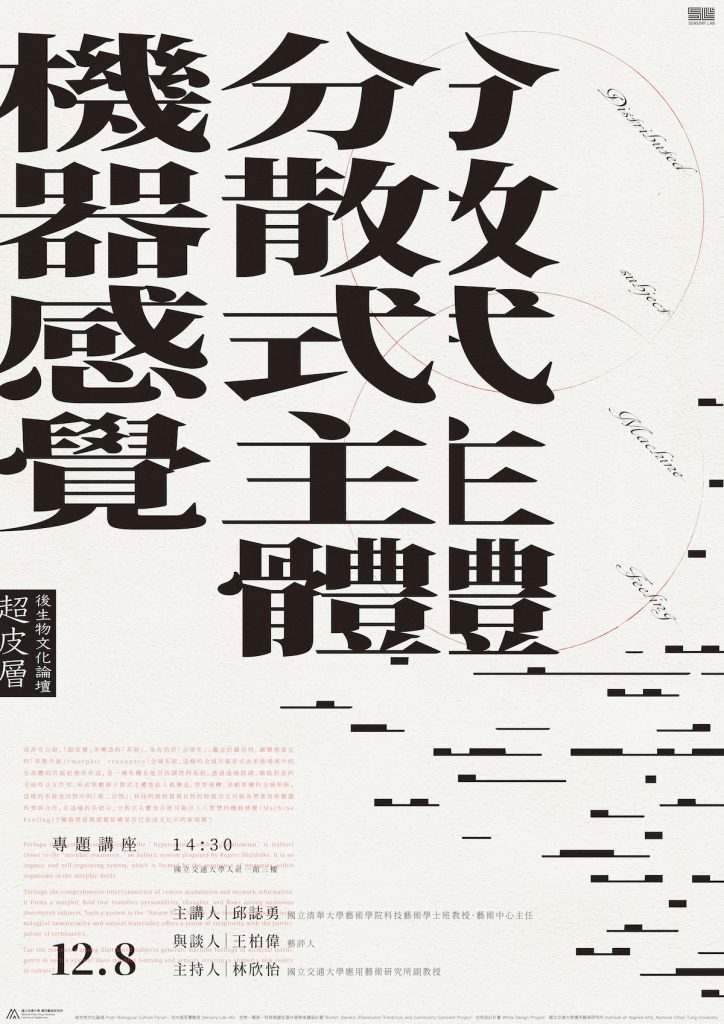 分散式主體—機器感覺
分散式主體—機器感覺
Distributed Subjects – Machine Feeling”
場次一 專題講座 12/08(二)
14:30-16:00(專題演講)-16:20-17:20(對談).國立交通大學人社一館三樓
主講人|邱誌勇 國立清華大學藝術學院科技藝術學士班教授,藝術中心主任
與談人|王柏偉 藝評人
主持人|林欣怡 國立交通大學應用藝術研究所副教授
或許可以說,「超皮層」所構造的「系統」,是有別於「全球化」、趨近於羅伯特.謝爾德雷克的「形態共振」(morphic resonance)全域系統。這樣的全域共振形式由形態場域中的生命體的共振記憶所形成,是一種有機且能自我調控的系統,透過遠端控調、網絡訊息的全面性交互作用,形成無數個分散式主體彼此人格傳送、思想移轉、流動異變的全域系統。這樣的系統是自然中的「第二自然」,科技的無物質與自然的物質交互共振為帶著技術藝識的參與合作,在這樣的系統中,分散式主體是否能共振出人工智慧的機器感覺(Machine Feeling)?機器學習與感覺結構是否已形成文化中的新現實?
It may be said that the “system” constructed by the ” hypercortex,” unlike “globalization,” is rather closer to the “morphic resonance,” an across-the-board system proposed by Rupert Sheldrake. It is an organic and self-regulating system, which is formed by the resonance of memories within organisms in the morphic fields. Through the comprehensive interconnection of remote modulation and network information, it forms the morphic field that transfers personalities, thoughts, and flows among numerous distributed subjects. Such a system is the “Nature II” in nature. The resonance between technological immateriality and natural materiality offers a vision of reciprocity with the participation of technoetics. Can the resonance among distributed subjects generate machine feelings of artificial intelligence in such a system? Have machine learning and sensory structures shaped a new reality in culture?
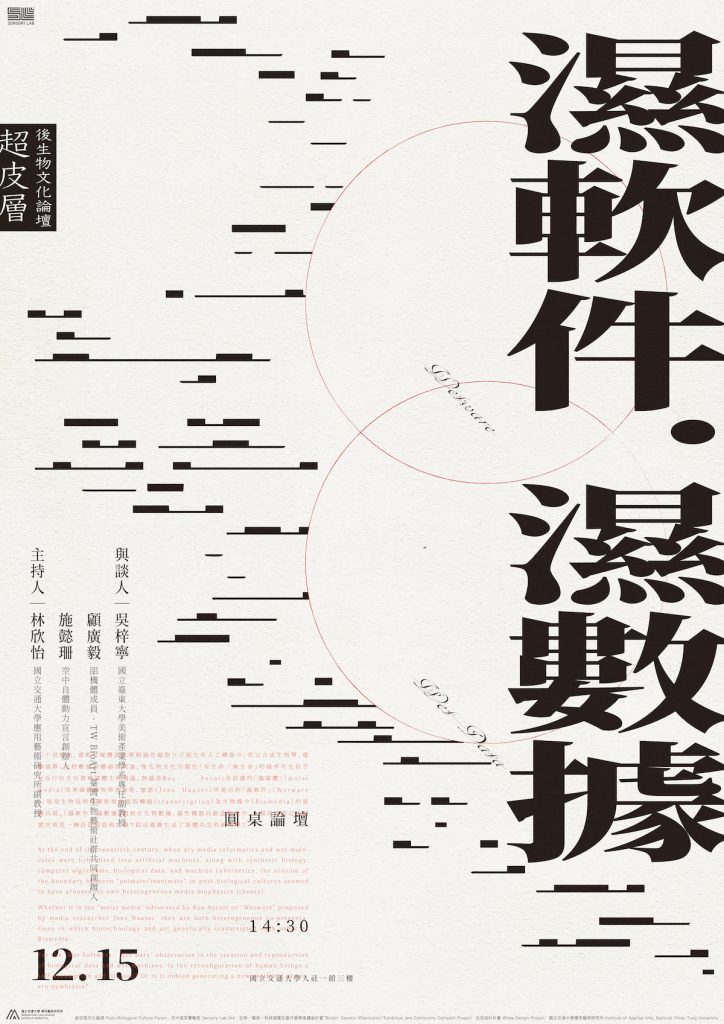 濕軟件—濕數據
濕軟件—濕數據
Wetware—Wet data
場次二 圓桌論壇 12/15(二)
14:30-16:00(對談人發表)-16:20-17:20(綜合對談).國立交通大學人社一館三樓
施懿珊| 新媒體藝術家,空中自體動力宣言創辦人
吳梓寧 | 國立臺東大學美術產業學系專任副教授
顧廣毅| 㗊機體成員,TW BioArt臺灣生物藝術社群共同創辦人
主持人|林欣怡 國立交通大學應用藝術研究所副教授
二十世紀末,當乾性媒體訊息學與濕性細胞分子混生至人工機器中,佐以合成生物學、電腦演算、生物數據與機器控制論,後生物文化中關於「有生命/無生命」的越界共生似乎已自行衍生出異種媒體生物理論。無論是Roy Ascott所倡議的「濕媒體」(moist media)或者媒體研究學者詹斯.豪瑟(Jens Hauser)所提出的「濕軟件」(Wetware),皆是生物技術與藝術彼此基因轉錄(transcription)為生物媒介(Biomedia)的異體共現。「濕軟件—濕數據」觀測在生物數據、濕性機器的創造繁殖中,人類的重新自我配置究竟是一種自我假設與幻覺?抑或確實生成了異體共生的新美學?
At the end of the twentieth century, when dry media informatics and wet molecules were hybridized into artificial machines, along with synthetic biology, computer algorithms, biological data, and machine cybernetics, the erosion of the boundary between “animate/inanimate” in post-biological cultures seemed to have given rise to heterogeneous media biophysics of its own. Whether it is “moist media” advocated by Roy Ascott or “Wetware,” proposed by media researcher Jens Hauser, those are all heterogeneous co-presentations of biotechnology and art genetically transcribed into each other as biomedia, both have themselves genetically changed by mutual transcriptions of biotechnology and art, hence they present heterogeneously. The “Wet Software – Wet Data” observation in the creation and reproduction of biological data and wet machines, is the reconfiguration of human beings a self-assumption and an illusion? Or is it indeed generating a new aesthetic of hetero-symbiosis.
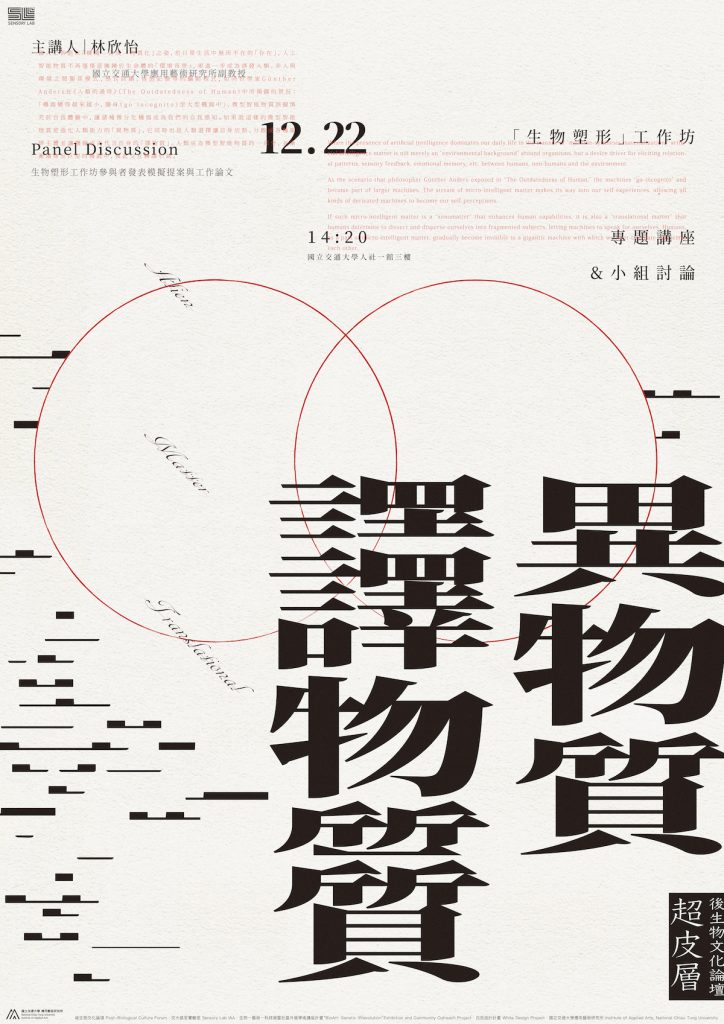 異物質—譯物質
異物質—譯物質
Alien Matter—Translational Matter
場次三 「生物塑形」工作坊專題講座與小組討論
14:30-15:20(講者演講)-15:30-17:30(提案發表).國立交通大學人社一館三樓
主講人|林欣怡 國立交通大學應用藝術研究所副教授
Panel Discussion |生物塑形工作坊參與者發表模擬提案與工作論文
當人工智能以「機械—合成—物質化」之姿,於日常生活中無所不在的「存在」,人工智能物質不再僅僅是圍繞於生命體的「環境背景」,更進一步誘發了人類、非人與環境之間關係模式、感官回饋、情感記憶等的驅動程式,成為哲學家Günther Anders在《人類的過時》(The Outdatedness of Human)中所揭露的景況:「機器變得越來越小,隱身(go incognito)至大型機器中」,微型智能物質流竄填充於自我體驗中,讓諸種微分化機器成為我們的自我感知。如果說這樣的微型智能物質是強化人類能力的「異物質」,它同時也是人類選擇讓自身切割、分散成各種細碎主體並讓機器成為代言自身的「譯物質」。人類成為微型智能物質的一部分,並漸漸隱身至巨型的機器中,彼此交互轉譯引誘。
When the presence of artificial intelligence dominates our daily life in the manner of “machine-synthesis -materialization,” artificial intelligence matter is not merely an “environmental background” around organisms, moreover, it has become a device driver for eliciting relational patterns, sensory feedback, emotional memory, etc. between humans, non-humans and the environment. As the scenario that philosopher Günther Anders exposed in “The Outdatedness of Human,” the machines “go incognito” and become part of larger machines. The stream of micro-intelligent device makes its way into our self-experience, allowing all kinds of derivated machines to become our self-perception. If such micro-intelligent matter is “xenomatter” that enhances human capabilities, it is also “translational matter” that humans determine to dissect and disperse ourselves into smaller subjects that let machines speak for ourselves. Human beings become part of micro-intelligent matter and gradually become invisible in a gigantic machine that inter-translate and elicit/lure/tempt each other.
超皮層—後生物文化論壇 Hypercortex: Post-Biological Culture Forum
主辦|交大感官實驗室.協辦|白色設計計畫 White Design Project.國立交通大學應用藝術研究所 Institute of Applied Arts, NCTU
